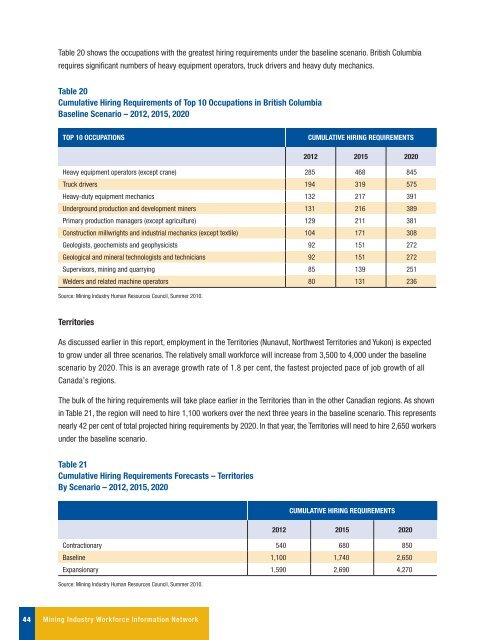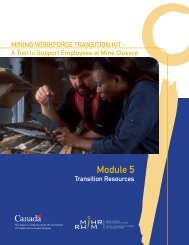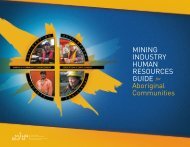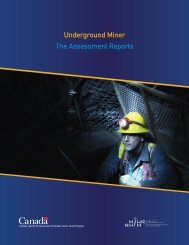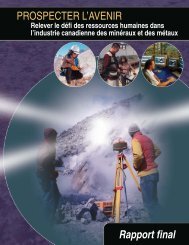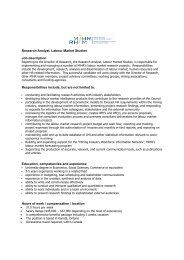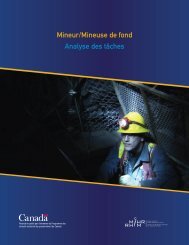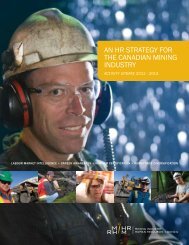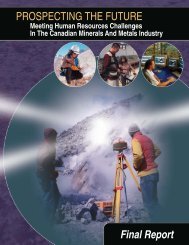Canadian Mining Industry Employment and Hiring Forecasts - MiHR
Canadian Mining Industry Employment and Hiring Forecasts - MiHR
Canadian Mining Industry Employment and Hiring Forecasts - MiHR
You also want an ePaper? Increase the reach of your titles
YUMPU automatically turns print PDFs into web optimized ePapers that Google loves.
Table 20 shows the occupations with the greatest hiring requirements under the baseline scenario. British Columbia<br />
requires significant numbers of heavy equipment operators, truck drivers <strong>and</strong> heavy duty mechanics.<br />
Table 20<br />
Cumulative <strong>Hiring</strong> Requirements of Top 10 Occupations in British Columbia<br />
Baseline Scenario – 2012, 2015, 2020<br />
TOP 10 OCCUPATIONS<br />
CUMULATIVE HIRING REQUIREMENTS<br />
2012 2015 2020<br />
Heavy equipment operators (except crane) 285 468 845<br />
Truck drivers 194 319 575<br />
Heavy-duty equipment mechanics 132 217 391<br />
Underground production <strong>and</strong> development miners 131 216 389<br />
Primary production managers (except agriculture) 129 211 381<br />
Construction millwrights <strong>and</strong> industrial mechanics (except textile) 104 171 308<br />
Geologists, geochemists <strong>and</strong> geophysicists 92 151 272<br />
Geological <strong>and</strong> mineral technologists <strong>and</strong> technicians 92 151 272<br />
Supervisors, mining <strong>and</strong> quarrying 85 139 251<br />
Welders <strong>and</strong> related machine operators 80 131 236<br />
Source: <strong>Mining</strong> <strong>Industry</strong> Human Resources Council, Summer 2010.<br />
Territories<br />
As discussed earlier in this report, employment in the Territories (Nunavut, Northwest Territories <strong>and</strong> Yukon) is expected<br />
to grow under all three scenarios. The relatively small workforce will increase from 3,500 to 4,000 under the baseline<br />
scenario by 2020. This is an average growth rate of 1.8 per cent, the fastest projected pace of job growth of all<br />
Canada’s regions.<br />
The bulk of the hiring requirements will take place earlier in the Territories than in the other <strong>Canadian</strong> regions. As shown<br />
in Table 21, the region will need to hire 1,100 workers over the next three years in the baseline scenario. This represents<br />
nearly 42 per cent of total projected hiring requirements by 2020. In that year, the Territories will need to hire 2,650 workers<br />
under the baseline scenario.<br />
Table 21<br />
Cumulative <strong>Hiring</strong> Requirements <strong>Forecasts</strong> – Territories<br />
By Scenario – 2012, 2015, 2020<br />
Cumulative <strong>Hiring</strong> Requirements<br />
2012 2015 2020<br />
Contractionary 540 680 850<br />
Baseline 1,100 1,740 2,650<br />
Expansionary 1,590 2,690 4,270<br />
Source: <strong>Mining</strong> <strong>Industry</strong> Human Resources Council, Summer 2010.<br />
44 <strong>Mining</strong> <strong>Industry</strong> Workforce Information Network


